Interior
How to Figure Out Interior Design Style
Get inspired to discover your unique interior design style through personal reflection and creative exploration, but what hidden gems will you uncover along the way?

To figure out your interior design style, start by reflecting on your aesthetic preferences. Consider colors, textures, and patterns that resonate with you. Create a Pinterest board to gather inspiration and spot recurring themes. Take an online interior design quiz for personalized style insights. Don't forget to analyze past favorites and emotional connections for deeper understanding. Mixing different styles can also bring out your personality, so explore what speaks to you. Each choice creates your unique space, leading you to a cohesive and inviting home. There's more to discover about enhancing your design journey and making it truly yours. Finding your personal design style is an ongoing process that evolves with time. It’s important to stay open to new ideas and inspirations as you refine and develop your aesthetic. Remember that your style can change and grow, so allow yourself the freedom to experiment and explore different looks. By staying true to your authentic self and following your instincts, you’ll continue finding your personal design style and creating a home that reflects your unique personality and taste.
Key Takeaways
- Take an online interior design style quiz to gain personalized insights into your unique aesthetic preferences.
- Create a Pinterest board to visualize and collect decor inspirations, identifying recurring themes and styles.
- Reflect on your favorite items and childhood inspirations to uncover foundational design preferences and emotional connections.
- Analyze the impact of colors and textures in your space, considering how they affect mood and atmosphere.
- Experiment with mixing different design styles while maintaining a unifying theme or color palette for a harmonious look.
Understanding Your Aesthetic Preferences

Understanding your aesthetic preferences is essential for creating a space that truly reflects who you are. Start with self-reflection—think about the colors, textures, and patterns that have consistently resonated with you. This isn't just about fleeting trends; it's about discovering your personal style that stands the test of time.
Exploring innovative architectural solutions can also offer insights into how different elements can harmonize within your space.
Use the three-word method to articulate your aesthetic. Isolate descriptive adjectives that capture your style's essence. This simplification helps streamline your design decisions. You might also conduct a self-interview, asking probing questions about your favorite items and the emotions tied to specific spaces. This thorough examination can reveal insights into your unique style.
Create a visual collection, like a Pinterest board, where you gather inspirations that reflect your likes. Look for recurring themes and elements that define your aesthetic.
Taking the Interior Design Style Quiz
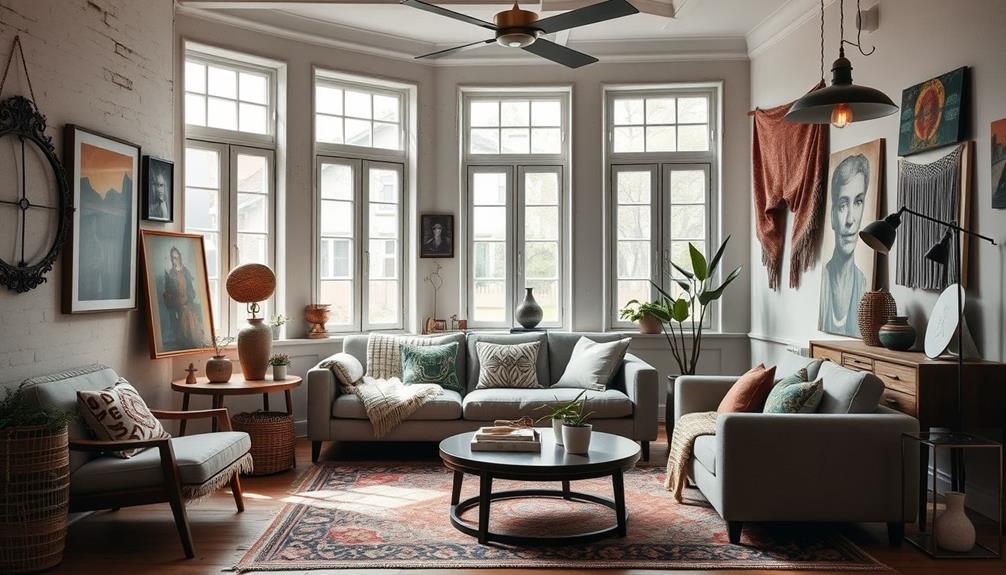
Taking the Interior Design Style Quiz is a great way to discover your unique style.
By answering a few targeted questions, you'll receive personalized design recommendations tailored to your preferences.
This fun quiz simplifies the process of finding the perfect decor to reflect who you are.
Discover Your Unique Style
Finding your unique interior design style can be an exciting journey, and an interior design style quiz is a great way to kick things off. By answering questions about your lifestyle, materials, and color preferences, you'll uncover insights into what resonates with you.
This fun and interactive process helps you discover your unique blend of decor styles, whether you lean towards Bohemian, Glam, or Midcentury Modern. For instance, exploring different styles like Mid-Century Modern Design can inspire you with iconic furniture pieces that blend nostalgia with contemporary flair.
The quiz simplifies the often overwhelming task of defining your personal aesthetic. It provides clarity on how to create a cohesive and meaningful atmosphere in your home. You might find that you embody a mix of several styles, allowing for a more flexible approach to decorating your space.
Once you complete the quiz, you'll receive personalized insights into your style archetype. This knowledge can guide you in selecting furniture and decor that truly reflects who you are.
Personalized Design Recommendations Await
Ready to reveal the secrets of your personal design style? Taking the Interior Design Style Quiz is your first step toward personalized design recommendations tailored just for you.
This engaging quiz dives into your lifestyle, materials, and color preferences, helping you find your design with precision. You might even discover that your aesthetic leans towards the modern farmhouse trend, characterized by neutral color palettes and natural materials.
As you answer the questions, you'll discover insights into your unique style archetype. Once you finish the quiz, you'll receive quiz results that not only guide your choice of furniture and decor but also show how to blend various aesthetics for a cohesive look.
What's even better? You get connected with designers who align with your identified style.
These professionals are ready to provide guidance tailored to your tastes, making your interior design journey smoother and more enjoyable.
Analyzing Popular Design Trends
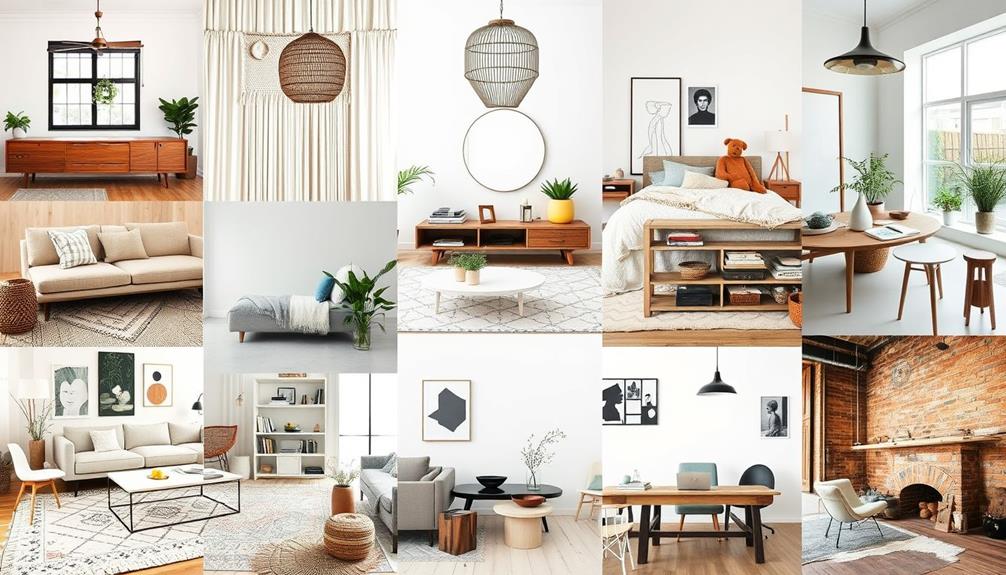
When looking at popular design trends, it's clear they often arise from cultural shifts and the desire for personal expression. Styles like Bohemian and Minimalism showcase how individual tastes shape home decor style, reflecting a need for both vibrancy and simplicity.
Social media platforms like Instagram and Pinterest play a huge role in this. They let you discover and imitate various aesthetics, though this can lead to fleeting preferences rather than lasting design styles. Additionally, trends like Cottagecore emphasize the importance of nature and tranquility, which resonates with a growing appreciation for serene environments the appeal of natural materials.
To truly analyze these trends, consider breaking them down into three descriptive words. For example, "rustic, romantic, soft" perfectly encapsulates the Cottagecore aesthetic. This method helps you pinpoint elements that resonate with your personal taste.
Additionally, trends like Japandi blend Japanese and Scandinavian aesthetics, emphasizing functionality and organic materials, which highlight a growing preference for sustainable living.
You might also notice the rise of multifunctional furniture, catering to urban dwellers. This reflects ongoing trends toward maximizing space efficiency and adaptability, essential for smaller living environments.
Reflecting on Past Favorites

Think back to your childhood inspirations, favorite travel memories, and influential art pieces that have shaped your taste.
These experiences often hold the key to understanding what styles truly resonate with you.
Childhood Inspirations
Reflecting on childhood inspirations can reveal a treasure trove of design preferences that resonate deeply with you. Think back to the decor styles present in your childhood home. Those familiar elements might evoke a sense of comfort and belonging that you want to recreate in the home you love today. The commitment to enhancing spaces reflects the importance of understanding personal history in shaping your design journey.
Consider the beloved colors, patterns, and themes that filled your early years. Were there specific hues that made you feel joyful? Maybe a cozy reading nook filled with your favorite books or a vibrant playroom sparked your imagination. These cherished memories can guide you in selecting design styles that align with your emotional connections.
Take time to analyze your childhood toys, books, or artwork. These items often showcase color palettes and styles that naturally draw you in. You might find that a particular shade or pattern still resonates with you today, waiting to be incorporated into your current space.
Creating a mood board or journaling about these childhood inspirations can clarify which design elements you want to embrace. By reflecting on your past, you'll uncover the unique features that can help shape a home you truly love.
Favorite Travel Memories
Childhood inspirations often lay the groundwork for your design preferences, but favorite travel memories can further illuminate your unique style. Reflecting on past adventures reveals colors, textures, and designs that resonate with specific destinations.
Think about how the warm hues of a sunset in Santorini or the rustic charm of a countryside retreat can influence your home decor.
Consider creating a visual scrapbook or mood board that captures the essence of these beloved places. This can serve as a wellspring of inspiration for your interior design choices.
As you analyze the architectural styles and decor elements from your travels, look for patterns or themes that align with your tastes. Maybe you love the sleek lines of modern design mixed with the warmth of rustic touches—this blend could define your style.
Don't forget to remember the emotions and atmospheres you experienced during your travels. By recreating those feelings in your home, you can achieve a more meaningful design that reflects your journey.
Ultimately, your favorite travel memories can guide your decor decisions and help you craft a space that feels uniquely yours.
Influential Art Pieces
Art holds the power to shape your interior design style, revealing personal aesthetic preferences and recurring themes that resonate deeply with you. Reflecting on your past favorite art pieces can uncover the colors, styles, and mediums that truly define your taste.
Consider how these artworks affect the mood in your spaces. For example:
- Bright, dynamic art suggests a love for lively, eclectic styles.
- Muted, serene pieces may indicate a preference for minimalism or modern aesthetics.
Analyzing where you enjoyed these pieces—like in homes or galleries—can clarify what environments inspire you. Keeping a visual diary or Pinterest board of your favorites tracks evolving tastes.
Engaging in conversations about influential art with friends can also help you discover hidden preferences. Sharing perspectives not only broadens your understanding but may inspire fresh design directions.
Mixing Different Design Styles

Mixing different design styles allows you to craft a space that truly reflects your personality and tastes. By combining eclectic elements, you can create a unique environment that showcases your experiences.
To achieve a harmonious look, focus on a unifying theme or a neutral color palette that ties everything together. Incorporating stylish wall clocks can enhance time management visually while adding a decorative touch. This cohesion guarantees that your space feels intentional rather than chaotic.
Incorporating a few key statement pieces from each style can strike the perfect balance, allowing you to display diversity without overwhelming the eye. For instance, modern's clean lines can pair beautifully with boho's vibrant patterns, enhancing the overall aesthetic.
Understanding the characteristics of each style helps you select complementary elements that work in tandem. Above all, prioritize personal comfort in your mixed-style design. Integrate your favorite decor items and cherished heirlooms to evoke positive emotions and memories.
Exploring Color and Texture Choices

Color and texture are the dynamic duo that can transform a room from ordinary to extraordinary. Your color choices greatly impact the mood of your space. Warm tones like reds and yellows create coziness, while cool hues such as blues and greens foster tranquility.
To elevate your design, consider incorporating diverse textures that add depth and interest. Mixing materials—think soft fabrics, sleek metals, and natural woods—enhances both aesthetics and tactile experiences. For instance, using cozy teenage girl room colors can create a comfortable ambiance that reflects personal style.
To achieve a balanced design, remember the 60-30-10 rule:
- 60% of a dominant color
- 30% of a secondary color
- 10% of an accent color
Patterns can also complement your color choices and textures. Using patterned textiles or decor can infuse personality without overwhelming the overall design.
When selecting colors and textures, apply the principles of color theory; complementary colors create harmony, while contrasting textures introduce visual interest.
Seeking Professional Design Guidance

While you might feel overwhelmed by the multitude of design choices available, seeking professional design guidance can considerably simplify the process of defining your interior design style.
Professional designers not only help you identify your unique style but also refine it to create a cohesive look throughout your home. Additionally, if you're considering a minimalist approach, you might find inspiration in the Tiny House Movement, which emphasizes functional design and sustainability.
By taking a style quiz at Havenly, you'll be matched with designers who provide tailored advice based on your preferences and existing furniture.
These experts play an essential role in budget management, ensuring that your furniture selection aligns with both your aesthetic desires and financial constraints. They'll guide you through every step, helping you make informed decisions that maximize functionality and visual appeal in your space.
You'll also gain access to a wider range of furniture and decor options that you mightn't discover on your own, ensuring your home reflects your individuality.
Client testimonials consistently highlight the reduced stress and increased satisfaction when collaborating with professional designers, particularly during the often-daunting furniture selection process.
Reviewing Client Success Stories
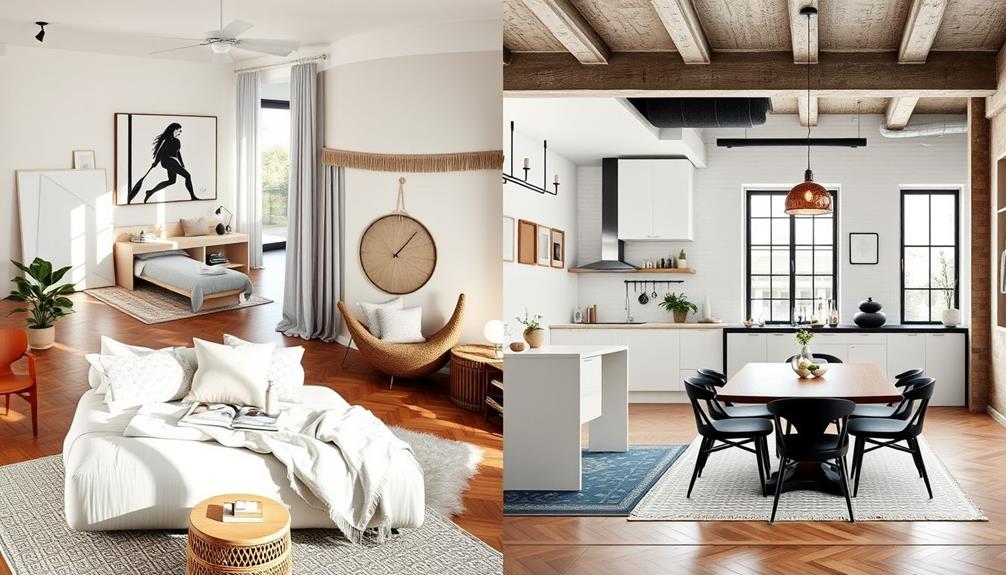
Client success stories reveal the transformative power of personalized design guidance. Through client testimonials, you can see how tailored support from Havenly designers has helped individuals discover and refine their unique interior design styles. Many clients, like Liz, experienced reduced stress during the furniture selection process, thanks to insights gained from the design quiz.
Here are some highlights from these inspiring stories:
- Seamless integration of various design elements, as shared by Pam, showcases how combining personal style with professional advice leads to harmony in your space.
- Clients appreciate the fun and collaborative nature of the design journey, making it an enjoyable experience rather than a chore.
- The blend of multiple design styles can create cohesive environments that truly reflect your personality and preferences.
- Positive feedback emphasizes the efficiency of identifying and embracing individual styles, resulting in successful home transformations.
These success stories illustrate the effectiveness of personalized design guidance. With the right support, you can commence your own journey to create a space that feels uniquely you, making your home a true reflection of your personal style.
Next Steps for Your Space

Having explored the inspiring journeys of clients who found their unique design styles, it's time to focus on the next steps for your own space.
Start by taking an online interior design style quiz; this can help you identify your unique preferences and provide tailored recommendations. Once you've got some insights, create a Pinterest board to collect and visualize decor inspirations that resonate with you. This will clarify your style direction.
Next, evaluate your current decor. Identify furniture pieces and decor items that evoke positive feelings and consider removing those that no longer align with your taste. This will help create a more cohesive environment.
Reflect on the desired atmosphere for your space by analyzing how colors, textures, and layouts impact your daily living and mood.
Conclusion
Now that you've explored your aesthetic preferences and analyzed various design trends, it's time to weave your unique style into your space. Imagine your home as a canvas, waiting for your personal brushstrokes of color, texture, and flair. Whether you blend styles or embrace a single theme, trust your instincts and let your personality shine through. With each choice, you're creating a haven that reflects who you are—your story brought to life in every corner.
Interior
How to Set up Interior Design Business
Inspiring your creativity, discover essential steps to launch an interior design business that captivates clients and transforms spaces. Are you ready to get started?

To set up your interior design business, start by defining your services—residential, commercial, or e-design. Identify your design style and create a mood board to clarify your vision. Choose a unique business name that resonates with your target audience and register it to secure your online presence. Build a professional website to showcase your portfolio, including high-quality images of past projects. Develop a marketing strategy using social media and industry networking. Finally, plan your finances to guarantee stability. There’s a lot more to explore on each step to help you succeed. Consider offering free consultations or design workshops to attract potential clients and demonstrate your expertise. Additionally, create an effective pricing strategy that reflects the value of your services and sets you apart from competitors. When developing your interior design plan, remember to prioritize creating spaces that are both functional and visually appealing. For more interior design plan tips, consider seeking mentorship or joining professional organizations to stay updated on industry trends and best practices.
Key Takeaways
- Define your services by identifying various types like residential and commercial, and create tailored packages for different client needs and budgets.
- Choose a unique business name that reflects your design style and resonates with your target audience, ensuring it’s legally available.
- Build a professional website showcasing your portfolio with high-quality images and SEO-optimized content to attract potential clients.
- Develop a comprehensive marketing strategy using social media, content marketing, and networking to enhance your visibility and credibility in the industry.
- Establish strong client relationships through initial consultations, regular updates, and detailed contracts to ensure transparency and satisfaction.
Define Your Services
Defining your services is essential for establishing a successful interior design business. Start by clearly identifying the types of services you’ll offer, whether it’s residential design, commercial design, e-design, or specialized options like eco-friendly design. This clarity helps potential clients understand exactly what you provide as an interior designer.
Next, create distinct service packages tailored to different client needs and budgets. By outlining what each package includes, you avoid confusion and set clear expectations. Develop compelling service descriptions that highlight your unique selling points and the specific problems your design services solve.
Consider offering a la carte options for additional services, but keep them limited to maintain focus and avoid overwhelming clients with choices. It’s vital that the scope of work for each service is well-defined.
Include deliverables like mood boards, paint palettes, and project timelines to manage client expectations effectively. This approach not only streamlines your operations but also enhances client satisfaction.
Identify Your Design Style

To create a successful interior design business, you need to identify your unique design aesthetic and target market.
Explore various styles, from modern to traditional, and see what resonates with both your vision and potential clients.
This clarity will help you tailor your services and attract the right clientele.
Unique Design Aesthetic
Often, identifying your unique design aesthetic is essential for attracting the right clientele and standing out in a crowded market. Start by researching various design styles, like mid-century modern, rustic, or industrial, to find what resonates with your personal taste and potential clients. For instance, incorporating elements from modern farmhouse decor trends can help you connect with clients who appreciate warmth and simplicity.
This exploration helps you carve out a niche that aligns with your skills and interests.
Creating a mood board can be incredibly helpful. Collect images, color palettes, materials, and layout inspirations that reflect your style preferences. This visual representation clarifies your design vision and can guide your projects.
Additionally, stay updated on current design trends and think about how they can be integrated into your unique aesthetic. This approach allows you to appeal to modern clients while maintaining your individuality.
Establishing a niche, such as eco-friendly design or vintage restoration, enhances your brand identity. This specialization not only differentiates you but also attracts specific client demographics seeking those services.
Target Market Identification
Understanding your unique design aesthetic naturally leads you to identify your target market. By pinpointing your design style, whether it’s mid-century modern or rustic farmhouse, you can attract specific clients who resonate with your vision.
This focus not only enhances your target market identification but also allows for effective niche marketing strategies that highlight your strengths.
Research shows that 70% of consumers prefer working with designers who specialize in a particular style, underscoring the importance of defining your aesthetic. This clarity helps you create a cohesive portfolio that appeals to your ideal clients, setting you apart from competitors.
Moreover, knowing your design style clarifies your service offerings, whether you provide full-service design or tailored e-design solutions.
Engaging with your audience through surveys or social media can give you deeper insights into their preferences, enabling you to refine your style and service packages.
Choose a Business Name
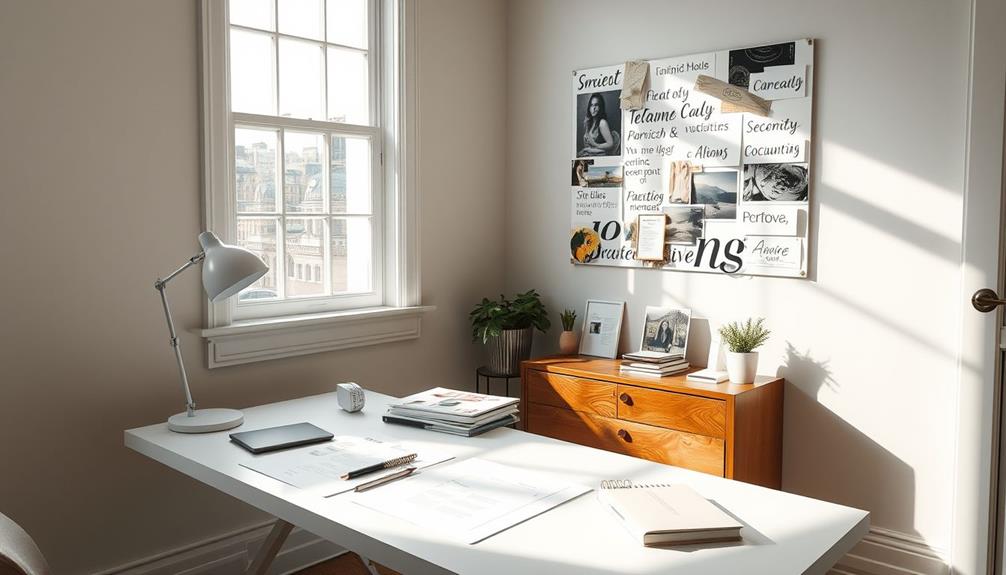
Choosing a business name is essential for establishing your brand identity in the interior design world.
You’ll want a name that’s unique and relevant to your style, while also making sure it’s not already in use.
Once you’ve settled on a name, register it with the appropriate state agency to comply with legal requirements and protect your brand.
Name Uniqueness and Relevance
Selecting a business name is essential for establishing your interior design brand. You want a unique name that reflects your design style and resonates with your target audience. This name should convey the essence of your services, making it clear what clients can expect from you.
Before settling on a name, conduct a thorough search to confirm its uniqueness. Check business registries and domain availability to avoid potential legal conflicts with existing businesses.
Remember, a name that’s easy to pronounce and remember will help clients connect with you more easily; complex names can create confusion and hinder brand recognition.
Incorporating your personal name or initials can add a personal touch, enhancing trust and familiarity. This approach helps establish a strong brand identity that stands out in the competitive interior design market.
Registration and Legal Considerations
Registering your business name is an important step in establishing your interior design firm. Your business name not only reflects your design style but also resonates with your target audience, enhancing brand recognition. Before moving forward, conduct a thorough search to verify your chosen name is unique and isn’t already in use to avoid legal conflicts.
Consider incorporating your personal name into the title, as this adds a personal touch and builds trust with potential clients. Once you’ve settled on a name, register it with your state’s Secretary of State office or a similar entity, which typically involves completing an application and paying a fee.
Additionally, securing a domain name that matches your business name is vital. This helps establish a professional online presence and supports your branding efforts.
Here’s a quick overview of the process:
| Step | Action |
|---|---|
| 1. Name Selection | Choose a unique business name |
| 2. Registration | Register with the Secretary of State |
| 3. Domain Registration | Secure a matching domain name |
Build Your Website
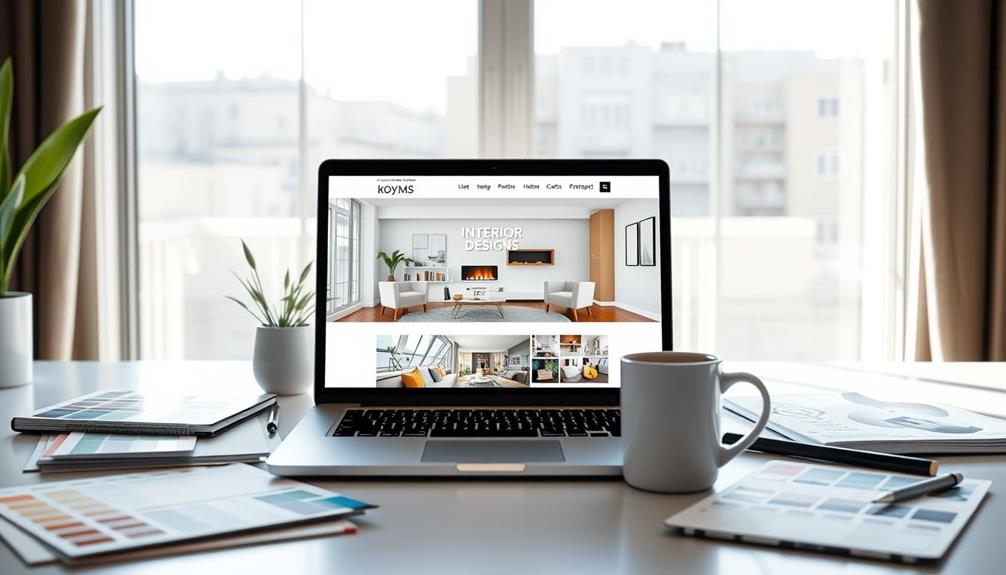
Building a website for your interior design business is vital, especially since it serves as your online portfolio and first impression for potential clients. Start by registering a memorable domain name that reflects your brand and is easy to spell, which enhances your online visibility.
Platforms like WordPress or Squarespace offer user-friendly templates, allowing you to build your website without needing extensive coding knowledge. Additionally, incorporating effective keyword clustering can enhance your SEO strategy and improve content discoverability.
Incorporate high-quality images of your design work, including before-and-after photos, to effectively showcase your portfolio. These visuals can capture the attention of potential clients and demonstrate your design skills.
Don’t forget about search engine optimization (SEO) to improve your website’s visibility in search rankings. Use relevant keywords, meta descriptions, and alt text for images to attract more visitors.
Lastly, make certain that your website is mobile-responsive and loads quickly. Given that 53% of mobile users abandon sites that take longer than three seconds to load, a fast and responsive design is essential.
Create a Portfolio

A strong portfolio is essential for showcasing your interior design skills and attracting potential clients. To create a portfolio that stands out, showcase a diverse range of projects that highlight various styles, spaces, and design elements. This versatility appeals to a broader clientele.
Include high-quality before-and-after photos to visually illustrate your design impact and the transformational journey of each project. These images speak volumes about your ability to transform spaces.
Incorporate detailed drawings and renderings, both 2D and 3D, to highlight your design concepts and spatial planning skills, making it easier for potential clients to envision your ideas.
Don’t forget to feature client testimonials alongside project descriptions. These testimonials should describe the challenges you faced, the solutions you provided, and the overall experience of working with you. This adds credibility and relatability to your work.
Lastly, regularly update your portfolio with recent projects and trends to keep it fresh and relevant. This guarantees potential clients see your current capabilities and style evolution, making your portfolio an effective tool in landing new clients.
Develop a Marketing Strategy

An effective marketing strategy is essential for launching and sustaining your interior design business.
Begin by establishing a strong online presence with a professional website that showcases your portfolio, services, and client testimonials. Optimize it for SEO to attract potential clients effectively.
To further enhance your credibility, consider sharing insights from industry resources such as exclusive design insights that can position you as a knowledgeable leader in the field.
Next, utilize social media platforms, especially visual-centric ones like Instagram and Pinterest, to share high-quality images of your designs. Engage with followers to create a loyal community and drive traffic back to your site.
Implement content marketing strategies by writing blog posts that offer design tips and trends. This not only enhances your credibility but also improves your website’s visibility in search engine results.
Networking plays a vital role too. Attend industry events, collaborate with real estate agents and contractors, and join professional associations to gain referrals and bolster your reputation.
Plan Your Finances

Marketing your interior design business lays the groundwork for attracting clients, but without a solid financial plan, sustaining that growth can be challenging. Start by maintaining savings that cover at least six months of operating expenses. This buffer will help you navigate income delays as you get your business off the ground.
Additionally, consider utilizing top-rated payment solutions for education that can streamline your payment processes and enhance client satisfaction.
Next, create a detailed budget that includes both startup costs—like design software, website development, and marketing expenses—and ongoing costs, such as rent and utilities. A well-structured budget is essential for tracking your financial performance.
Establish a clear payment schedule for clients to guarantee consistent cash flow. Typically, you should ask for a 50% deposit upfront, 35% at three-quarters completion, and the final balance before project delivery. This strategy helps manage your expenses while keeping the project on track.
Consider using reliable payment processors like Stripe or PayPal for client transactions. These platforms can facilitate easier and more secure payments, making the process smoother for both you and your clients.
Establish Client Relationships
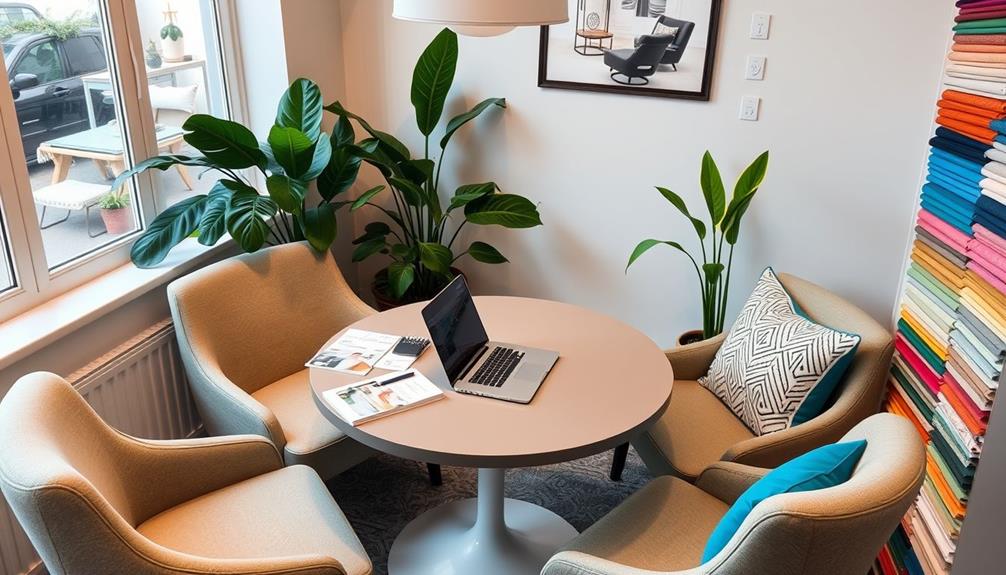
Building strong client relationships is essential for the success of your interior design business. It all starts with initial consultations where you focus on understanding your clients’ needs, preferences, and budgets. This tailored approach sets the stage for effective communication throughout the design process.
Regular updates and check-ins not only enhance client satisfaction but also foster trust.
Creating detailed contracts is vital; they outline project scope, timelines, and costs, helping manage client expectations and reducing the likelihood of disputes. Remember, transparency goes a long way in building rapport.
After project completion, don’t underestimate the value of personal touches. Handwritten thank-you notes or follow-up calls can greatly enhance client interactions and encourage repeat business.
Additionally, actively seek client feedback once the project wraps up. This not only shows your commitment to their satisfaction but also provides insights for service improvements.
Conclusion
So, you’ve set up your interior design business, right? You’ve defined your services, built a portfolio, and even launched a snazzy website. Ironically, while you thought the hardest part was the design, it’s actually mastering the art of client relationships and finances that’ll truly test your skills. Who knew creating beautiful spaces would come with such complex puzzles? Embrace the chaos, because in this business, it’s not just about what’s inside the room; it’s about what’s inside you.
Interior
How to Interior Design a Bedroom
Navigate the essentials of bedroom interior design to create your perfect retreat, but there’s a secret to adding that extra touch of character.

To design your bedroom, start by setting a clear budget and planning your layout. Gather inspiration to create a mood board that reflects your style and the atmosphere you want, whether it's cozy or energizing. Choose quality furniture like a comfortable bed and functional nightstands, and select a cohesive color palette. Incorporate various textures through textiles and add personalized decor, like artwork or travel mementos. Don't forget to enhance your lighting with dimmable bulbs and task lights. By following these steps, you'll transform your space into a retreat that resonates with your personality; there's more to uncover about filling your space with character. When it comes to adding those finishing touches, consider incorporating vignette interior design tips to bring depth and personality to your bedroom. For example, create small styled groupings on shelves or dressers using items like candles, books, and decorative objects. This will add visual interest and tie the room together. Additionally, play with different layers and heights to create a sense of dimension in your space.
Key Takeaways
- Establish a budget and categorize expenses to prioritize essential items while allowing for unexpected costs.
- Create a mood board to visualize colors, textures, and themes that reflect your personal style.
- Select foundational furniture pieces and consider multi-functional options to optimize space usage.
- Implement various lighting strategies, including warm and task lighting, to enhance comfort and functionality.
- Personalize the space with artwork, decor, and plants to create a welcoming and unique atmosphere.
Budgeting and Planning
When it comes to designing your bedroom, budgeting and planning are vital steps you can't overlook. Start by establishing a clear budget, categorizing expenses into must-haves, nice-to-haves, and low-priority items.
Don't forget to allocate an additional 10-20% for unexpected costs. A well-organized spreadsheet will help you track line items and cost estimates, guaranteeing you maintain oversight throughout the design process.
Next, measure your room dimensions accurately. Create a layout plan using graph paper or free floor planner apps to visualize furniture placement before making any purchases. This step is imperative since understanding interior design dimension standards guarantees comfortable spacing and functionality in your bedroom.
If any renovations or installations are needed, obtain at least three contractor bids. Comparing these costs and quality will empower you to make informed decisions while sticking to your budget.
Mood and Inspiration Development

Creating the perfect mood for your bedroom starts with gathering inspiration that reflects your personal style and desired atmosphere.
Begin by developing a mood board filled with images, colors, and textures that resonate with you. This will help clarify your vision and guide your design ideas.
To effectively create a mood board, consider the following:
- Identify the purpose of the space: relaxation or productivity?
- Choose a springboard object, like artwork or textiles, that captures your desired style and color scheme.
- Analyze recurring themes in your collected inspirations to refine your direction.
- Ascertain all elements fit within your budget and hold personal significance.
As you gather your inspirations, think about how natural light will interact with your chosen colors and textures.
Whether you opt for a traditional or modern aesthetic, keep in mind that the right mood is an important feature in any small bedroom.
Furniture and Decor Selection

Selecting the right furniture and decor is essential for crafting a functional and inviting bedroom. Start by prioritizing foundational pieces like a quality bed, nightstands, and effective storage solutions. Look for durable options that can withstand daily use.
If space is tight, consider multi-functional furniture, such as storage beds or ottomans, to maximize efficiency without compromising aesthetics. For added charm, consider incorporating wrought iron beds as a focal point, which can enhance the rustic appeal of your bedroom.
Next, choose a cohesive color palette for your furniture and decor. Opt for neutral tones for larger items to guarantee flexibility with accessories and allow for seasonal updates. This approach keeps your bedroom feeling fresh and versatile.
To add warmth and visual interest, incorporate various textures through textiles like bedding, curtains, and rugs. These elements enhance comfort and make your space more inviting.
Lastly, don't forget to personalize your bedroom. Add artwork and decor accessories that reflect your personal style and interests. Mixing different sizes and styles can add character and uniqueness, making your bedroom truly yours.
Lighting Strategies

Lighting plays a pivotal role in setting the mood and functionality of your bedroom. To create a versatile and inviting atmosphere, you'll want to implement effective lighting strategies that combine ambient, task, and accent lighting. Here are some essential elements to take into account:
- Warm light: Use dimmable bulbs to adjust brightness, enhancing comfort for various activities. Consider incorporating stylish wall clocks that not only help with time management but also serve as decorative pieces.
- Task lighting: Incorporate bedside lamps or sconces for reading, ensuring they're positioned to minimize glare and shadows.
- Accent lighting: Highlight artwork or architectural features to add visual interest and depth to your bedroom design.
- Natural light: Strategically place mirrors to reflect daylight and use window treatments like sheer curtains with blackout shades for privacy and light control.
Additionally, smart lighting options, such as automated dimmers and smart bulbs, can enhance functionality and convenience by allowing you to easily adjust the lighting based on the time of day.
Personalization and Greenery

Personalizing your bedroom with greenery can transform the space into a serene retreat. Incorporating purifying plants, like spider plants or snake plants, not only enhances air quality but also creates a calming atmosphere that promotes better sleep.
You'll find that the presence of these low-maintenance plants, such as succulents or peace lilies, fits seamlessly into your busy lifestyle while adding a touch of nature. To guarantee your plants thrive, consider using best soil for String of Hearts plants to create a healthy environment.
To further enrich your personalized atmosphere, display personal artwork or family photographs on the walls or shelves. These decorative items provide emotional comfort and a deeper connection to your space.
Additionally, integrating travel souvenirs or handmade crafts can inject character and warmth into your bedroom decor, making it feel more inviting.
Don't forget about seasonal decor updates! Changing plant arrangements or artwork throughout the year keeps your room dynamic and invigorating.
This ongoing personalization not only fosters a unique environment but also reflects your evolving tastes and interests. With these thoughtful touches, your bedroom will become a true reflection of who you are, blending comfort and style for a perfect retreat.
Conclusion
In designing your bedroom, you've envisioned your style, curated your colors, and selected your furnishings. You've balanced your budget, embraced your inspiration, and illuminated your space. Now, as you add personal touches and greenery, you're not just creating a room; you're crafting a sanctuary. So, breathe in the tranquility, soak in the beauty, and revel in the comfort. Your dream bedroom awaits, ready to be a reflection of you—serene, stylish, and uniquely yours.
Interior
How to Use Autocad for Interior Design
Transform your interior design process with AutoCAD’s powerful tools and features; discover essential techniques that will elevate your designs to the next level.
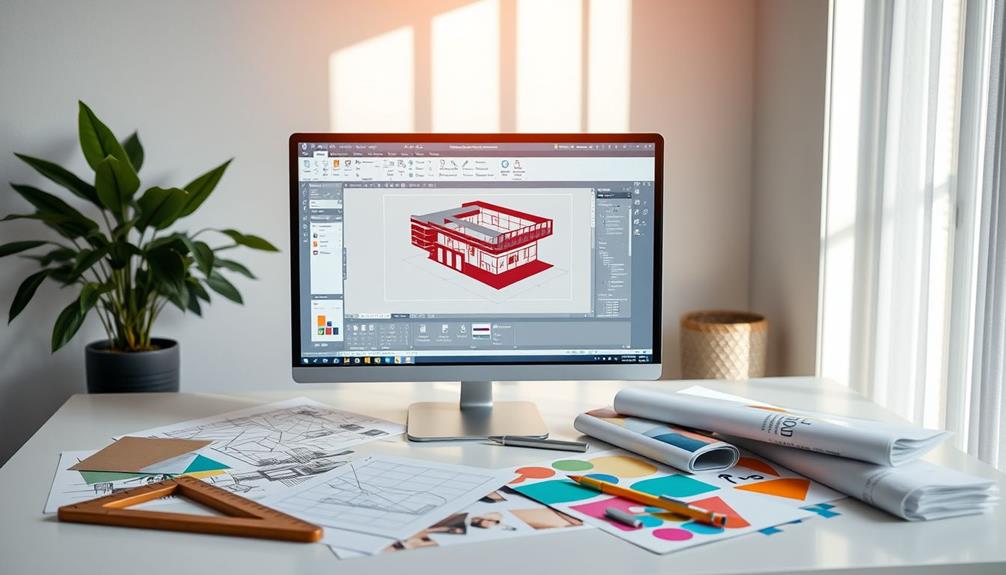
To use AutoCAD for interior design, start by mastering its tools for creating precise 2D and 3D models. Set up basic dimensions and use the Line tool for accurate furniture layouts. Take advantage of the RoomMaker function to convert your 2D plans into 3D visualizations, helping clients better understand your designs. Organize your projects using layers for different elements like furniture and finishes, and utilize the Trim tool for clean, polished drawings. With these skills, you'll enhance your efficiency and presentations, making your designs stand out. There's even more to uncover that can enhance your design process further. Additionally, explore AutoCAD’s rendering capabilities to bring your visuals to life with realistic textures and lighting. For those looking to make 3d interior design free of charge, consider integrating AutoCAD with complimentary tools like SketchUp Free to expand your creative options. By combining these resources, you can deliver stunning, professional-grade designs without exceeding your budget.
Key Takeaways
- Master CAD tools, especially AutoCAD, to enhance efficiency and meet industry standards in interior design projects.
- Utilize the RoomMaker function to convert 2D floor plans into realistic 3D visualizations for improved client presentations.
- Organize design elements efficiently using layers, ensuring clarity and ease of modifications throughout the design process.
- Apply advanced dimensioning tools for precise measurements, ensuring adherence to design standards and accuracy in models.
- Use reusable blocks for common design elements to streamline processes and maintain consistency across multiple projects.
Importance of CAD in Interior Design
In today's fast-paced interior design industry, mastering CAD tools like AutoCAD is essential for success. With AutoCAD, you can create precise 2D and 3D models quickly, which greatly reduces the time spent on traditional hand-drawing methods. This efficiency is critical in a sector where deadlines are tight and client expectations are high.
Additionally, incorporating elements from modern farmhouse bedrooms can enhance the overall design process, as the serene atmosphere these spaces offer can be visually communicated through effective CAD modeling.
The software's RoomMaker function is a game-changer, allowing you to convert 2D floor plans into 3D visualizations effortlessly. This feature not only enhances client presentations but also aids in better spatial understanding, making it easier for clients to grasp your design intentions.
Proficiency in AutoCAD is often seen as the industry standard; about 90% of design-oriented businesses expect you to be skilled in its use. The CAD drawings you produce serve as the foundation for accurate technical documents and effective project communication, which are essential for successful collaboration with engineers and builders.
Overview of AutoCAD Capabilities

AutoCAD equips you with powerful tools for creating both 2D and 3D models, ensuring your designs are precise and accurate.
You can enhance your presentations with realistic visualizations that impress clients and communicate your ideas effectively.
With these capabilities, you'll streamline your design process and elevate your interior design projects.
2D and 3D Modeling
Often, designers rely on AutoCAD for both 2D and 3D modeling, as it offers powerful tools to bring their visions to life. With AutoCAD, you can create detailed 2D floor plans and easily convert them into 3D models using the RoomMaker function. This enhances your ability to present design concepts to clients in a more engaging way.
The advanced 3D modeling capabilities allow you to visualize your space realistically, complete with accurate dimensions and materials. You can utilize various drawing tools, like the Line tool and the Hatch option, to craft intricate designs and add color, improving the visual appeal of your models.
AutoCAD also supports layer management, enabling you to efficiently organize different elements of your project. This feature makes modifications and revisions in both 2D and 3D views much simpler.
Plus, its compatibility with widely used file formats like DWG and DXF guarantees seamless collaboration with other design professionals and easy sharing of projects across various platforms.
In short, AutoCAD is an invaluable tool for turning your interior design ideas into stunning, tangible results.
Precision and Accuracy
Creating detailed 2D and 3D models in AutoCAD sets the stage for achieving high levels of precision and accuracy in your interior design projects. This software is renowned for its ability to produce exact measurements, which are essential for accurately representing interior spaces.
With advanced dimensioning tools, you can specify distances and angles, ensuring every element adheres to defined standards.
AutoCAD's layer management system allows you to organize complex drawings effectively, making it easy to manipulate and adjust individual components without impacting the entire project. This flexibility enhances precision, enabling you to focus on specific details while maintaining an accurate overall design.
Additionally, the software lets you create reusable blocks for common elements like furniture and fixtures. This feature streamlines your design process, ensuring consistency across various projects and enhancing accuracy in your layouts.
AutoCAD's 3D modeling capabilities also enable you to visualize spaces realistically, providing a thorough understanding of how elements interact in three dimensions. This depth of visualization further improves the overall accuracy of your designs, allowing you to confidently present your ideas to clients.
Enhanced Design Presentations
Effective design presentations are essential for communicating your vision to clients, and AutoCAD excels in this area. With its powerful features, you can create detailed 2D floor plans and easily convert them into 3D models using the RoomMaker function. This capability enhances the clarity of your presentations, making it easier for clients to visualize your ideas.
AutoCAD's advanced layer management tools help you organize complex layouts, allowing for effortless modifications without losing track of individual components. Additionally, the software's block creation function enables you to save and reuse design elements, streamlining the process for multiple presentations.
Here's a quick overview of AutoCAD's capabilities for enhanced design presentations:
| Feature | Benefit | Purpose |
|---|---|---|
| RoomMaker | Easily convert 2D to 3D models | Visual clarity |
| Layer Management | Organize complex designs | Simplifies modifications |
| Block Creation | Save and reuse design elements | Maintains consistent aesthetics |
| 3D Modeling | Realistic visualizations | Understand spatial dynamics |
| File Compatibility | Supports DWG, DXF, etc. | Enhances collaboration |
Basic Steps for AutoCAD Design
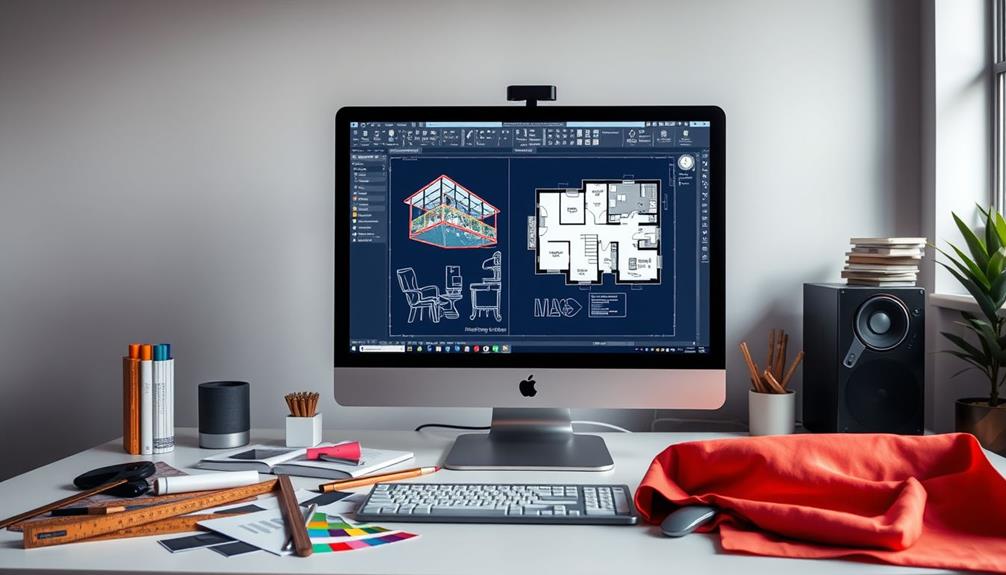
Precision is key when starting your design in AutoCAD, as it lays the foundation for your entire project. To begin, set up basic dimensions for your furniture using the Line tool. This guarantees accurate placement and spacing throughout your layout.
Once you've established your initial layout, utilize the Move command to arrange chairs around a table. Dividing the sections appropriately will help create a cohesive look.
Next, create side elevation drawings. These drawings provide thorough views of your design, enabling better visualization of spatial relationships within the space.
To achieve accurate modeling, trace chair designs from sample images. This practice enhances the quality of your 2D and 3D representations, making your work more professional.
Advanced Features of AutoCAD

In AutoCAD, advanced features can greatly streamline your design processes and enhance your projects' overall quality.
You'll find tools that improve visualization techniques, making it easier to showcase your ideas to clients.
Plus, organizing complex projects through layers allows for better management of various elements, ensuring clarity throughout your design work.
Streamlining Design Processes
AutoCAD offers powerful tools that can greatly streamline your design processes, making your workflow more efficient. One essential tool is the Trim function, which helps you quickly remove unnecessary lines and elements, ensuring a polished final product. This is particularly useful in complex designs where cleanliness is crucial for clarity.
Another handy feature is the Ray tool, which allows for accurate alignment of elevations with top-down views. This improves your spatial understanding and enhances the presentation quality of your interior designs.
By experimenting with layers, you can effectively organize various project elements, making management and visibility much easier.
The Hatch option adds color to your designs, enhancing visual appeal and making presentations more engaging for clients.
Plus, with AutoCAD's advanced 3D modeling capabilities, you can create realistic representations of spaces. This not only facilitates better communication of your design intent but also helps clients visualize your ideas more clearly.
Enhancing Visualization Techniques
To elevate your design presentations, utilizing advanced visualization techniques in AutoCAD can make a considerable difference. Start by diving into the 3D modeling features, which allow you to create realistic representations of interior spaces. This helps clients visualize the final design more effectively. Use the Ray tool to align elevations with top-down views, guaranteeing accurate representation from multiple perspectives.
Experimenting with layers can also enhance your visualization techniques. By organizing different aspects of the project—like furniture, lighting, and finishes—you can manage complex designs efficiently.
When it comes to refining your visuals, the Trim tool is invaluable. It cleans up unnecessary lines, improving the overall clarity and professionalism of your presentation.
To add depth and mood to your designs, incorporate the Hatch option. This not only adds color but also texture, greatly enhancing the visual appeal.
Organizing Complex Projects
How can you effectively manage the complexities of an interior design project? Organizing your design plans in AutoCAD is key to streamlining your workflow.
Start by utilizing layers to separate different elements like furniture, walls, and electrical layouts. This way, you enhance visibility and keep your designs tidy.
Use the Trim tool to clean up unnecessary lines and intersections, ensuring your designs look polished and professional.
When working with elevations, incorporate the Ray tool to align them with top-down views, which helps maintain consistency and accuracy throughout your documentation.
Experiment with various drawing tools, such as Polylines and Splines, to create intricate shapes that elevate your overall design.
Additionally, take advantage of advanced features like blocks to create reusable components. This not only saves time but also maintains consistency across multiple project files.
Popular Software for Designers

In the world of interior design, choosing the right software is essential for translating your creative vision into reality. One of the most recognized tools is AutoCAD, which designers use for creating precise architectural drawings and layouts. Its industry-standard status means that mastering AutoCAD is critical for beginners, providing the technical drafting skills needed to succeed.
Another popular choice is SketchUp Pro. Its intuitive 2D and 3D modeling capabilities make it a favorite for conceptual design, allowing you to visualize interior spaces quickly. This software enables you to experiment with different layouts and aesthetics, making your design process more dynamic.
For more complex projects, Autodesk Revit stands out with its Building Information Modeling (BIM) capabilities. It offers extensive tools that support detailed architectural design and enhance collaborative project management, making it ideal for larger teams.
Proficiency in multiple design software, including AutoCAD, SketchUp, and Revit, greatly boosts your marketability and appeal to clients. By diversifying your skills, you not only enrich your design toolkit but also position yourself as a versatile designer ready to tackle various projects.
Learning Resources for AutoCAD

Mastering AutoCAD is easier than ever, thanks to a variety of learning resources tailored for aspiring interior designers. You can explore numerous platforms that cater to your needs, making it simple to start your journey.
| Resource Type | Description |
|---|---|
| Online Courses | Platforms like Skillshare offer thorough AutoCAD classes with free trials. |
| Autodesk Tutorials | Autodesk provides extensive tutorials and guides, perfect for beginners. |
| Community Forums | Engage with forums dedicated to AutoCAD for peer support and networking. |
| Certification Programs | Consider Autodesk's certification to boost your professional credibility. |
| Local Workshops | Participate in hands-on workshops for real-time practice and guidance. |
These learning resources for AutoCAD are invaluable as you build your skills. Whether you prefer online courses or local workshops, you'll find options that fit your learning style. Don't underestimate the power of community forums; they can provide insights and tips that enhance your understanding. By taking advantage of these resources, you'll be well on your way to mastering AutoCAD, setting a solid foundation for your interior design career. Start exploring today!
Career Opportunities With Autocad

Proficiency in AutoCAD can open doors to numerous career opportunities in fields like architectural drafting, interior design, and civil engineering. As an interior designer skilled in AutoCAD, you can expect to earn about $55,000 annually; however, your salary could double with advanced AutoCAD skills due to the high demand for expertise in this area.
Having a methodical approach to design can enhance your work quality, similar to the key traits of successful SQA engineers.
Job roles such as architectural drafters, electrical drafters, and mechanical drafters commonly require AutoCAD proficiency, providing a variety of employment options. Many design firms prioritize candidates with AutoCAD certification, which shows a validated level of expertise and enhances your job prospects in competitive markets.
Additionally, the increasing trend toward Building Information Modeling (BIM) and collaborative project environments further boosts the need for AutoCAD-trained professionals. This makes you more attractive to potential employers looking for candidates who can effectively contribute to complex projects.
Embracing AutoCAD not only hones your design skills but also considerably widens your career horizon, making it an essential tool in your professional toolkit. So, investing time in mastering AutoCAD can truly pay off in your career journey.
AutoCAD Certification and Education

Many aspiring interior designers find that obtaining AutoCAD certification greatly boosts their career prospects. With a variety of certificate and degree programs available, you can choose the one that fits your learning style, whether in-person or online.
Here are three key benefits of pursuing AutoCAD certification:
- Improved Professional Credibility: Successfully passing exams like the AutoCAD Certified User (ACU) credential shows employers you have the skills they need.
- Enhanced Job Prospects: Certification can make you a more competitive candidate in the design field, opening doors to new opportunities.
- Accessible Learning Path: You don't need a formal degree to get started with AutoCAD, making it a viable option for anyone looking to enhance their design skills.
Programs like the NYIAD course offer extensive preparation for AutoCAD certification, including practice tests and essential theoretical knowledge.
Additionally, continuous education is vital to keep up with evolving software and industry standards. By committing to ongoing learning, you'll avoid developing bad habits and stay ahead in your interior design career.
Getting certified could be the step you need to elevate your professional journey.
Conclusion
In wrapping up, using AutoCAD for interior design isn't just a trend; it's a game changer. You might find yourself creating stunning spaces you never thought possible, all while honing skills that open doors to exciting career opportunities. Coincidentally, each project you tackle can lead to unexpected connections and collaborations, enriching your professional journey. So, immerse yourself, explore the advanced features, and watch your design dreams come to life—who knows what amazing paths await you?
-

 Interior3 months ago
Interior3 months agoHow to Start a Business in Interior Design
-

 Interior3 months ago
Interior3 months agoHow to Use Autocad for Interior Design
-

 Interior3 months ago
Interior3 months agoHow to Set up Interior Design Business
-

 Interior3 months ago
Interior3 months agoHow to Interior Design a Bedroom
-

 Texts4 months ago
Texts4 months agoEngaging Illusions: The Art of LED Installation Experience
-

 Texts4 months ago
Texts4 months agoExploring Art’s Transformation Through Material and Meaning
-

 Texts4 months ago
Texts4 months agoExploring the Dynamics of Artistic Practice and Public Engagement
-

 Texts4 months ago
Texts4 months agoExploring Financial Landscapes Through Art and Technology


























